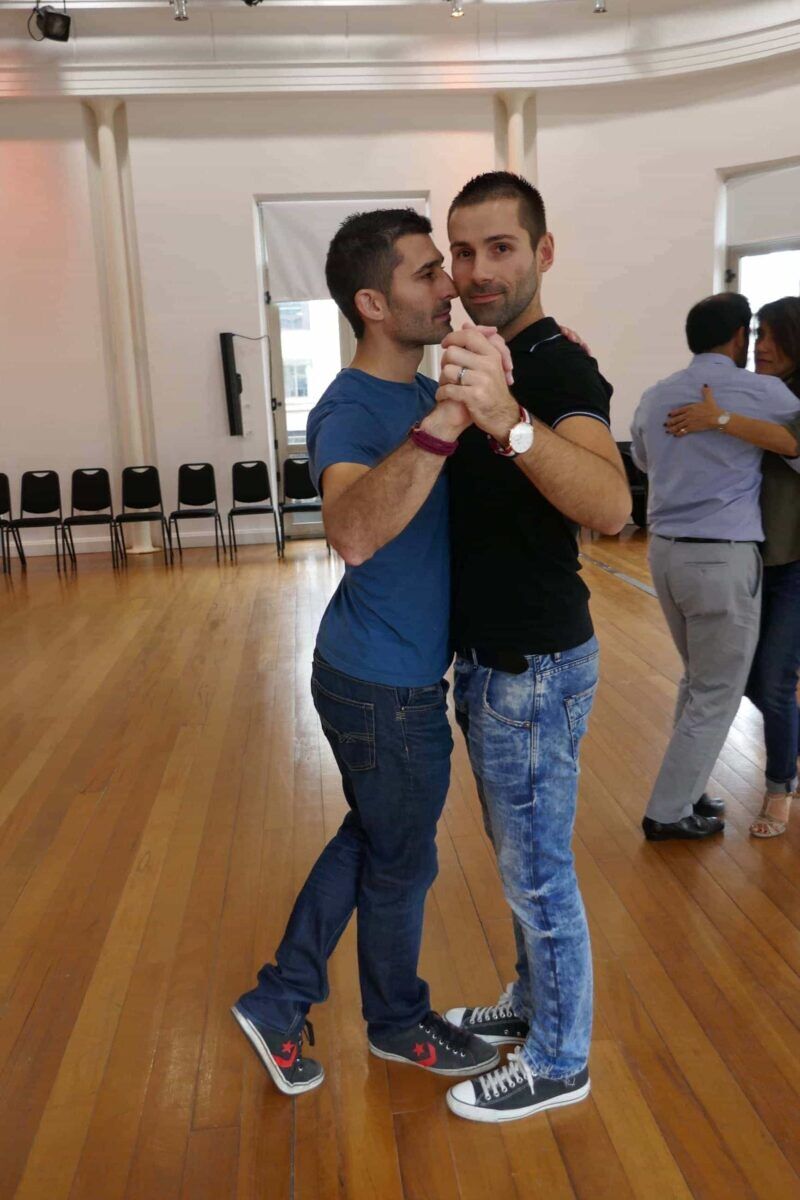Step inside Argentina’s only queer tango studio
Tucked away in Buenos Aires, Tango Cuir keeps its exact location discreet. But this isn’t minimalism – it’s protection.

Tango is passion; tango is romance; tango is heterosexual. Mr. & Mrs. Smith is famous for its Brangelina tango scene. “Tango: Maureen” starts with Mark and Joanne cosplaying as a hetero couple. “El Tango de Roxanne” in Moulin Rouge!, Baz Luhrmann’s gayest movie according to Google AI, features 50 women grinding on their male partners’ jalapeños.
Even my brain, hardwired to think gay thoughts, instantly conjures a male and female dancer when I hear the word “tango.” And yet, at Tango Cuir, Argentina’s first and only queer tango studio, founder Anahí Carballo seeks to change that.
Tucked away in Buenos Aires, the birthplace of tango, Tango Cuir keeps its exact location discreet. There’s no neon sign outside, no overtly queer décor. But this isn’t minimalism – it’s protection. With anti-LGBTQ+ sentiment on the rise thanks to Argentine president Javier Milei’s homophobic and transphobic rhetoric, Carballo knows she must find ways to protect the studio from this growing hostility. In this way, the very existence of Tango Cuir is a form of rebellion.
Pack your bags, we’re going on an adventure
Subscribe to our weekly newsletter for the best LGBTQ+ travel guides, stories, and more.
Subscribe to our Newsletter today
Related
The legend of the lesbian wolf girls at Vassar College
On campus, you’ll occasionally hear about the “Wolf Girls”—lesbian folklore passed down from the all-women’s college days.
To understand Tango Cuir’s historical significance, it’s perhaps important to know the history of tango itself.
Though it’s now conflated with cis women in red ruffled dresses spinning around stern, elegant gentlemen in silk pants, modern tango began as a strictly male affair. In late 19th-century Buenos Aires, working-class and immigrant men perfected the art form in bars and brothels as they waited for sex workers to start their shifts – to open up for business, if you will.
They dipped, twirled, and swayed, pawing each other’s lower backs and staring into each other’s eyes, all while maintaining their heterosexual identity. Mind you, this was before the trial of Oscar Wilde brought homosexuality out of the penal codes and into the public eye. Looking into another man’s eyes and telling him that you loved him wasn’t gay, yet.
But sadly, male-on-male twirling eventually became the stuff of fairy tales, and tango became a heterosexualized enterprise.
In this way, Carballo’s founding of Tango Cuir is a political statement and a return to the dance’s roots. It’s also a way to make tango once again palatable for queer Argentinians. After growing up disillusioned by the misogynistic undertones of tango – the glorification of partially undressed women, their bodies commanded by male leaders – Carballo wanted to create a teaching environment where her students could switch gender roles and same-sex couples could dance freely.
This is a far cry from Argentina’s traditional milongas, or dance halls. “In a traditional milonga,” Carballo explains, “there are a lot of matters that aren’t considered, like the possibility that there could be a situation of harassment, a situation of abuse, a situation of mistreatment, a situation of symbolic or physical violence.”
At Tango Cuir, on the other hand, consent and communication are of utmost importance. Before the first trill of the violin, there’s an understanding: this is a safe space.
Such safe spaces are ever more precious in today’s Argentina. Since taking office, President Javier Milei has banned gender-inclusive language in his government and has shut down the Ministry of Women, Gender and Diversity. In an early 2025 speech, he even likened “gender ideology” – a code for homosexuality – to child sexual abuse. Such language has had a galvanizing effect on homophobes throughout the country.
“I confess that I feel more afraid than before,” says Carballo. “Because what President Milei does against LGBTQ+ rights is that he not only acts against rights, but he convinces society of those beliefs… And people who kept quiet before, now they don’t keep quiet. And they tell us… If they want to get inside my house and hit me, [they can], because there’s nothing that covers us under the law.”
Carballo and her students have started participating in public acts of protest. At the Milonga del Orgullo Antifascista y Antirracista (the Antifascist and Antiracist Pride Milonga), members of Carballo’s studio tangoed in protest at the iconic Plaza del Congreso.
“To the closet we will not return,” the event’s poster read. “NEVER AGAIN.”
Perhaps just as importantly, Carballo and her students continue to embrace queer joy at Tango Cuir week after week, dancing their routines and demolishing the closet with every step.
Join the GayCities newsletter for weekly updates on the best LGBTQ+ destinations and events—nearby and around the world.

 Mark
Mark 





